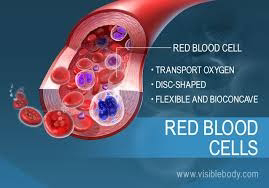Blood🩸
Blood = Cells + Plasma
Function of blood
- Conveying nutrients
- Eliminating waste products
- Caring oxygen and carbon dioxide
- Regulating body temperature
- Maintaining acid base balance
Composition of blood plasma
- Water
- Protein (fibrinogens, globulins, albumins)
- Other solutes
- Electrolytes
- Non protein nitrogen substance (urea, uric acid, creatine, creatinine, (ammonium salts)
- Nutrients (glucose, lipids, amino acids (
- Blood gasses (oxygen, carbon dioxide, nitrogen)
- Regulatory substances (hormones, enzymes)
Red blood cells (erythrocytes)
- Normal findings
- Adult/elderly
Male : 4.7 - 6.1
Female : 4.2 - 5.4
- Children
Newborn :4.8-7.1
2-8 weeks :4.0-6.0
2-6 weeks :3.5-5.5
6 months - 1 year :3.5-5.2
1-6years :4.0-5.5
6-18years :4.0-5.5
Abnormal findings
Increased levels
- High altitude
- Congential heart disease
- Polycythemia vera
- Dehydration/hemoconcentration
- Cor-pulmonale
- Pulmonary fibrosis
- Thalassemia trait
- Severe COPD
Decreased levels
- Hemorrhage
- Hemolysis
- Anaemia
- Hemoglobinopathy
- Advanced cancer
- Bone marrow failure
- Leukemia/lymphoma
- Chronic / renal disease
- Chemotherapy
- Rheumatoid disease
- Sub acute endocarditis
- Prosthetic valves
- Multiple myeloma
- Over hydration
- Dietary deficiency
Interfering factors
- Normal decrease are seen in RBCs during pregnancy because of normal body fluid increase and dilution of the RBCs
- Person living at high altitudes have increase RBCs
- Hydration status : dehydration factitiously increases the RBC count, and overhydration decrease the RBC count
- Drugs that may cause increased RBC levels include erythropoietin and gentamicin
- Drugs that decreased RBC levels are many including those that decrease marrow production or those that cause hemolysis
Total WBCs
- An increased total WBCs count (WBCs >10, 000) usually indicates infection, inflammation, tissue necrosis, or leukaemic neoplasia. Trauma or stress, either emotional or physical may increase the WBC count.
- A decreased total WBC count occurs in many forms of bone marrow failure
Platelets
Causes of thrombocytosis
- Acute bleeding and blood loss
- Alllergic reactions
- Cancer
- Major surgery
- Pancreatitis
- Iron deficiency
- Vitamin deficiency
- Heart attack
Causes, thrombocytopenia
- Leukemia
- Some types of anemia
- Viral infections, such as hepatitis C or HIV
- Chemotherapy drugs
- Heavy alcohol consumption
White blood cells (leukocyte)
Normal findings:Total WBCs
- Adult /child >2years : 5000- 10,000/mm (SI units)
- Child <2years : 6200-17, 000/mm
- Newborn 9000-30, 000/mm
Differential count
Granulocyte:contain specific granules and nonspecific (azurophilic) granule
- Neutrophils
- Eosinophils
- Basophils
Agranulocyte: contain only nonspecific (azurophile) granule
- Monocyte
- Lymphocyte
Interfering factors
- Physical activity and stress may cause an increase in WBC and differential values
- Pregnancy (final month) and labor may cause increase WBC and differential values
- Patients who have had a splenectomy have a persistent, mild elevation of wbc count.
- Drug that may cause increase wbc including:
Adrenaline, allopurinol, aspirin, chloroform, epinephrine, heparin, quinine, steroids, and triamterene.
- Drug that may cause decrease wbc including:
Antibiotic, anticonvulsants, antihistamine, antimetabolites, antithyroid drug, arsenicals, barbiturates, chemotherapeutic agents, diuretics, and sulfonamides.
Neutrophil
- 55-70./. Of leukocyte Or 2500-8000mmcubic
- Diameter 12-15
- Segmented nucleus 3 -5
- 2type of granules:
Specific granules : lysozyme, lactoferein, collagenase
Azurophile granule
- Are product in 7 to 14days and exits in the circulation for only 6 hrs.
- The primary function of the neutrophil os phagocytosis
Causes of neutophilia
- Acute infection
- Acute stress
- Eclampsia
- Gout
- Myelocyteic leukemia
- Thyroiditis
Causes of neutropenia
- Aplastic anemia
- Chemotherapy influenza
- Viral infection
- Addison disease
- Widespread severe bacterial infection
Monocyte
- 2-8./. Of leukocyte Or 100-700 per mm cubic
- Diameter 12-24
- Kidney -shape nucleus
- Belong to agranulocyte
- Differentiate into macrophage in tissue
- Primary function
1. Phagocytosis
2.Producing cytokines and activating inflammation response
3. Acting as antigen-presenting cells
Causes of monocytosis:
- Chronic inflammatory disorders
- Viral infections infectious mononucleosis
- Tuberculosis
- Parasitea (malaria)
Causes of monocytopenia:
- Aplastic anemia
- Hairy cell leukemia
- Drug therapy (Prednisone)
Eosinophil
- 1-4./. Of leukocyte Or 50-500mm cubic
- Diameter 10-15
- Bilobed nucleus
- 2type of granules:
1.Specific granules
2.Azurophilic granules
- Primary function
1.Defense against parasites
2. Modulation of response in allergic reaction
3.Phagocytosis
Lymphocyte
Dr. Mahalakshmi Raghunath








Comments
Post a Comment